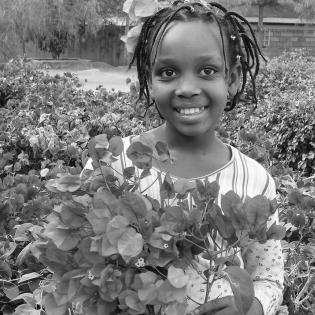A Beautiful World
The learner will:
- brainstorm ideas for taking action for the common good to make the world more beautiful.
- define philanthropy as giving time, talent, and treasure for the common good.
- flower petals, herbs, or other item from nature
- read-aloud copy of the book Miss Rumphius by Barbara Clooney
Instructions
Anticipatory Set:
With children seated in a circle, have them close their eyes as you walk by and rub soft rose petals on their hands or cheeks or hold a fragrant flower near their noses. When they open their eyes, show them a beautiful item from nature. Ask, What are some ways we get a more beautiful world? Some of these things may reflect inner beauty (peace, kindness).
Before reading the book Miss Rumphius by Barbara Clooney, say, "This is a story about a philanthropist who made the world more beautiful." A philanthropist is someone who gives their time, talent, and treasure for the common good of the community. Tell them to listen for how and why she did this as you read the book.
While you are reading, stop periodically to ask the children to describe Miss Rumphius (brave, creative, smart, selfless).
After reading, discuss the following questions:
- Why did Mrs. Rumphius want to do something to make the world more beautiful?
- How did her grandfather inspire her?
- How did Miss Rumphius share her time, talent, and treasure for the common good? Recall the definition of philanthropy (sharing time, talent, or treasure or taking action for the common good).
- Has anyone ever inspired you?
- What choice did Miss Rumphius have? Do you think choice is important when you are a philanthropist, or is it better if someone tells you what to do?
- Was Miss Rumphius selfish or selfless with her time, talent, and treasures? Give some evidence for your answers.
- How did she show commitment to her work of making the world more beautiful?
Discuss how Miss Rumphius was working alone, but as a member of a community. What community job did she hold? How did she help people? When she traveled, did she become part of other communities? What communities do you belong to?
Tell the children they have the opportunity to be philanthropists in their community like Miss Rumphius. Maybe their actions will inspire others to look for ways to help. This is the concept of serial reciprocity (paying it forward).
Brainstorm possible service projects for the environment that make the world more beautiful. This may include planting, weeding, cleaning garbage out of a natural place, bringing potted plants to people, or doing something unrelated to flowers. Remember to also think of beauty that you cannot see (love, kindness, clean air).
Philanthropy Framework
-
Strand PHIL.I Definitions of Philanthropy
-
Standard DP 01. Define Philanthropy
-
Benchmark E.1 Define philanthropy as the giving and sharing of time, talent, or treasure intended for the common good.
-
-
Standard DP 02. Roles of Government, Business, and Philanthropy
-
Benchmark E.5 Recognize that volunteering requires freedom of choice.
-
-
-
Strand PHIL.II Philanthropy and Civil Society
-
Standard PCS 02. Diverse Cultures
-
Benchmark E.4 Demonstrate listening skills.
-
-
-
Strand PHIL.III Philanthropy and the Individual
-
Standard PI 01. Reasons for Individual Philanthropy
-
Benchmark E.1 Describe one reason why a person might give or volunteer.
-
Benchmark E.4 Give an example of how citizens act for the common good.
-
-
